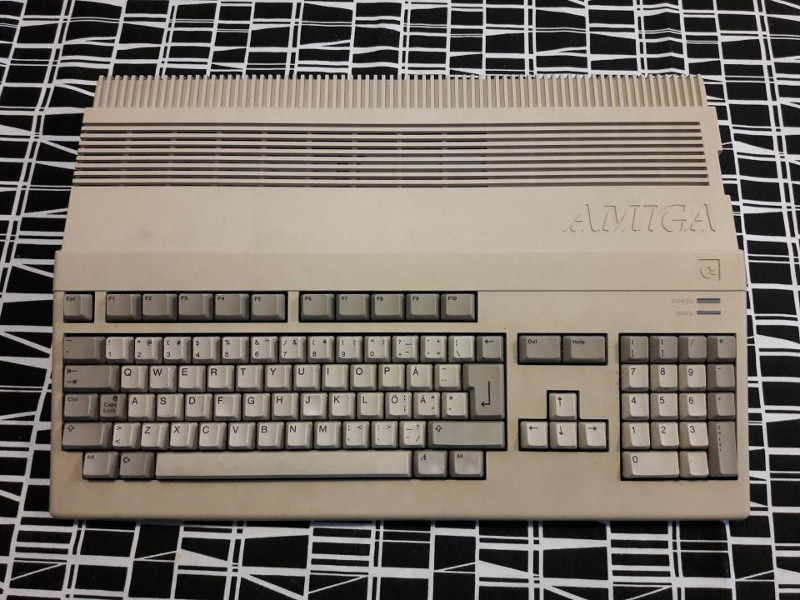Just because something is “never used” doesn’t mean it’s good. [Inkoo Vintage Computing] learned that lesson while trying to repair an Amiga 500 and finding parts online that were claimed to be “new” in that they were old stock that had never been used. The problem was that in the last 30 years the capacitors had dried out, rendering these parts essentially worthless. The solution, though, was to adapt a modern PSU for use on the old equipment.
The first hurdle to getting this machine running again was finding the connector for the power supply. The parts seemed to have vanished, with some people making their own from scratch. But after considering the problem for a minute longer they realized that another Commodore machine used the same parts, and were able to source a proper cable.
Many more parts had to be sourced to get the power supply operational, but these were not as hard to come across. After some dedicated work with the soldering iron, the power supply was put to use running the old Amiga. Asture readers will know that [Inkoo Vintage Computing] aren’t strangers to the Amiga. They recently were featured with a nondestructive memory module hack that suffered from the same parts sourcing issues that this modification had, but also came out wonderfully in the end.
















You can also replace the caps in an old PSU yeah? I ask because I have an A500 in the closet and I’d like to ensure it keeps working
Yea as long as that’s the only parts that are bad on it. It’s easy enough to find schematics and replacement caps for them.
Even worth doing in some new ones, the caps they use in cheap ones can be pretty crap tastic. Assuming you’d rather take the time instead of buying a better model.
So true!
I’m not familiar with A500 power supply but I do know Commodore have taken crappy path with C64 power supplies. Nearly all of the black brick are filled with epoxy and couldn’t be opened for repair. What’s more, they decided not to include any safety design like crowbar circuit so if something inside fails, the C64 would get a lot more than 5v on the 5v rail and fry chips.
C64 power supply are easily replaced with modern version that can supply 5v DC and 9v AC, and if one absolutely need to stick with original C64 power supply there’s a C64 Saver somewhere on Ray’s web site.
Sure you can but SHOULD you? Even cheapo modern power supplies are so much more efficient than those of yesteryear. Save the planet, not the vintage power supply right?
Ok, that makes your vintage computer a little less authentic. But.. if you hide the new one in the chassis then what’s to notice?
I had to do something like this on a Vic-20 though there all I needed was +5V and 9V AC so all I needed was guts of a router PSU and a transformer from a modem.
IIRC all the 9v AC was used for was the cassette drive, so if you don’t need that…
Vic 20 can run on 12V car battery.
It makes me angry he took a plug destined for a C128 instead of just picking up one of MANY spare Amiga power supplied available. They are cheap and common on ebay both working and broken, why oh why reduce the supply of plugs for C128 users desperate for a PSU that is FAR rarer than Amiga ones. :(
erm it’s the same plug.
So why dont you C128 owners grab an old amiga power supply which are far less rare, cut the plug off and if it really bothers you spray it black.
There’s still plenty of these connectors left https://www.soigeneris.com/commodore-128-amiga-500-600-square-din-5-pin-male-connector – and they do advertise it for Amiga as well, it’s not reserved for C128 only. :)
We don’t have eBay in Finland, and not everybody on eBay is willing to sell stuff abroad. Older power supplies are also different for different regions, so UK and US that have the biggest selection are out, either because of different mains voltage or different power connector. (We have 230V/50Hz with Schuko plugs, so e.g. German equipment is compatible.) Also, international mail is needed, and this makes heavy things like power supplies more expensive to buy from abroad. On local internet auctions Amiga power supplies are available only occasionally.
Also, I wanted a modern PSU. From an old Amiga PSU I could have used just the cable with the power connector, but I think destroying vintage equipment like that is much worse than using new components that may become rare at some point again. Cutting off the essential cable from a broken vintage PSU would turn that from something that is probably repairable to just electronic waste.
Thank you for the link! I have a 128 that I had to hack together a supply for, and ended up ripping the pins out of a DIN-5 and making a connector frame out of epoxy and hot glue. It works, but it’s ugly and bound to get shorted out if it’s not fully seated.
The Amiga 500 teardown is also quite interesting: https://inkoovintagecomputing.wordpress.com/2018/01/18/amiga-500-teardown/
Ugh as long as it gets rid of the original black brick. Those things were a bit rough around the edges iirc. I have faced something similar with 80s and 90s synths that have failed power supplies and reallllllly expensive repair parts. Luckily there is a good deal of room inside these synths and one can cram a micro atx psu in there as these series seemed to rely on negative voltage a good bit. It is great to save a few hundred and get them back in working order while questioning the original designers’ attempts at creating a power supply system so obtuse in today’s designs.
Nice,we read all very nice old “re-load” is as old school :-)